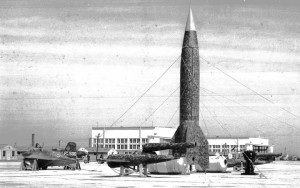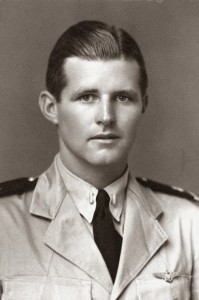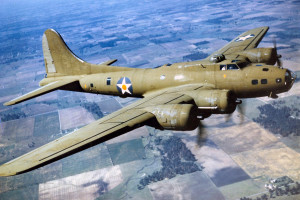By Alan Axelrod
Winston Churchill titled a chapter of his monumental history of World War II “The Wizard War.” It was all about the incredible technological innovations the war both produced and demanded, including such Allied advances as radar and the arsenal of Nazi “wonder weapons,” the most famous of which were the early cruise missile known as the V-1 and the world’s first ballistic missile, the V-2.

The pilotless V weapons—“vengeance weapons,” as propaganda minister Joseph Goebbels called them—were built for just one purpose: terrorizing populations into submission. They were nevertheless true wonders of technology massively accelerated by war. To counter them, the British and Americans hitched their own technological prowess to a seemingly inexhaustible genius for improvisation that pushed technology beyond what had been tested at the time.
When, for example, it became clear that conventional fighter pursuit techniques were not effective at downing the V-1s, RAF pilots quickly learned to maneuver their aircraft so that its wing broke up the airflow above the wing of the incoming V-1. This required sliding the fighter’s wingtip to within six inches of the lower surface of the V-1 wing while flying at 400 mph. The maneuver flipped the V-1 wing up, disrupting the craft’s gyros, and sending it into an uncontrolled dive. Executed close to the Channel and away from population centers, the crash was relatively harmless.
The V-1 was a stubby-winged cruise missile, fast, but still vulnerable to the fastest RAF fighter planes. The V-2, however, flew at 3,580 miles per hour in a trajectory that reached the stratosphere—as high as 128 miles—too high and fast to be shot down. The U.S. Army Air Forces and, mostly independently, the U.S. Navy therefore improvised a weapon capable of destroying the V-2s on the ground, while they were still awaiting launch in hardened ferroconcrete bunker fortresses arrayed along the French side of the English Channel at the Pas de Calais.

Lieutenant General Jimmy Doolittle, commanding officer of the Eighth U.S. Air Force, knew all about desperate innovation. On April 18, 1942, just five months after Pearl Harbor, Doolittle did the impossible by leading sixteen twin-engine B-25 medium bombers off the deck of the U.S. aircraft carrier Hornet to raid Tokyo and other Japanese cities. Two years later, he championed Operation Aphrodite, a plan to install radio control equipment in “war-weary” four-engine B-17s, pack the planes with a dozen tons of high explosive, and fly them by remote control directly into the German launch sites. The state of radio control was so rudimentary that live pilots were required to get the flying bombs off the ground. Once airborne, they armed the payload and established radio contact with the manned mother ships that would remotely pilot them into their targets. Then they bailed out over England before the now-pilotless “drone” reached the English Channel.
It was the closest thing to a suicide mission since the Doolittle Raids, and only a few volunteered for it. U.S. Navy Lieutenant Joseph P. Kennedy Jr. was the eldest son of the former ambassador to Great Britain. Having embraced Prime Minister Neville Chamberlain’s now-infamous appeasement policy, the senior Kennedy was forever branded a defeatist.
Joe Jr. volunteered to fly in Project Anvil, the navy counterpart of Aphrodite. His PB4Y-1 (navy version of the B-24 Liberator) was packed with 12 tons of torpedo explosive. The navy had been working on remote-control flight both longer and more intensively than the army and had created far more sophisticated radio-control technology. But the electronics used to actually arm the most lethal explosive package prior to Hiroshima, had been quickly thrown together on a plywood circuit board so crude that one officer who saw it compared it to “something you’d make with a number two Erector set and Lincoln Logs.”

Joe Jr. took off from an RAF base in England on August 12, 1944. Eighteen minutes into the mission, his aircraft exploded over Newdelight Wood near the Suffolk hamlet of Blytheburgh. Kennedy’s commanding officer, Commander James Smith, flying in an observation aircraft, later remarked that “nothing larger than a basketball could have survived the blast.” Kennedy and his single crew member, Lieutenant Wilford John “Bud” Willy, died instantly.
They had paid the price of war or, more precisely, the price of desperate improvisation a “wizard war” demanded. The rocket speed of technological advance called for a new breed of hero. Driven by a hunger to redeem the Kennedy name from his father’s errors of political and moral judgment, by lifelong competitiveness with his younger brother, Lieutenant (jg) John F. Kennedy, hero of PT-109, and, more selflessly, by a passionate desire to spare London further V-weapon devastation, Joseph P. Kennedy Jr. answered the call.
Historian Alan Axelrod is the author of Lost Destiny: Joe Kennedy Jr. and the Doomed WWII Mission to Save London the business bestsellers Patton on Leadership and Elizabeth I, CEO, the Great Generals series books Patton, Bradley, and Marshall, and many books on American and military history. He lives in Atlanta, Georgia.
